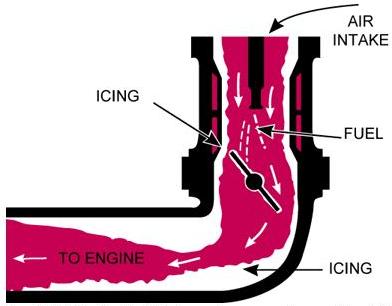| Mixture Control
A “mixture control” in the cockpit is provided to change the fuel flow
to the engine to compensate for varying air densities as the airplane changes
altitude.
Carburetors are normally calibrated at sea level pressure to meter the
correct amount of fuel with the mixture control in a “full rich” position. As
altitude increases, air density decreases. This means that a given volume of air
does not weigh as much at higher altitudes because it does not contain as many
air molecules. As altitude increases, the weight of air decreases, even though
the volume of air entering the carburetor remains the same. To compensate for
this difference, the mixture control is used to adjust the ratio of fuel-to-air
mixture entering the combustion chamber. This also regulates fuel consumption.
If the fuel/air mixture is too rich, i.e., too much fuel in terms of
the weight of air, excessive fuel consumption, rough engine operation, and
appreciable loss of power will occur. Because of excessive fuel, a cooling
effect takes place which causes below normal temperatures in the combustion
chambers. This cooling results in spark plug fouling. Conversely, operation with
an excessively lean mixture, i.e., too little fuel in terms of the weight of
air, will result in rough engine operation, detonation, overheating, and a loss
of power.
To summarize, as the airplane climbs and the atmospheric pressure
decreases, there is a corresponding decrease in the weight of air passing
through the induction system. The volume of air, however, remains constant, and
since it is the volume of airflow which determines the pressure drop at the
throat of the venturi, the carburetor tends to meter the same amount of fuel to
this thin air as to the dense air at sea level. Therefore, the mixture becomes
richer as the airplane gains altitude. The mixture control prevents this by
decreasing the rate of fuel discharge to compensate for the decrease in air
density. However, the mixture must be enriched when descending from altitude.
Follow the manufacturer’s recommendation for the particular airplane being
flown to determine the proper leaning/enriching procedures.
| Carburetor Icing
The vaporization of fuel, combined with the expansion of air as
it flows through the carburetor, causes a sudden cooling of the mixture.
The temperature of the air passing through the carburetor may drop
significantly within a fraction of a second. Water vapor in the air is
“squeezed out” by this cooling and, if the temperature in the carburetor
reaches 0° C (32° F) or below, the moisture will be deposited as frost or
ice inside the carburetor passages. Even a slight accumulation of this
deposit will reduce power and may lead to complete engine failure,
particularly when the throttle is partly or fully closed. [Figure
2-8]
Conditions Conducive to Carburetor Icing
On dry days, or when the temperature is well below freezing, the
moisture in the air is not generally enough to cause trouble. But if the
temperature is between -7° C (20° F) and 21° C (70° F), with visible
moisture or high humidity, the pilot should be constantly on the alert for
carburetor ice. During low or closed throttle settings, an engine is
particularly susceptible to carburetor icing. |
 |
|
Figure 2-8.—Formation of ice (white) in the fuel intake system may
reduce or block fuel flow (red) to the
engine. |
|
